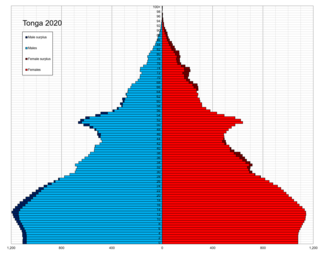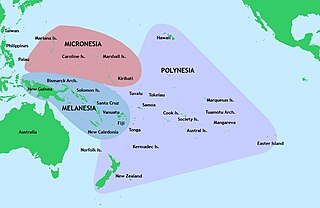Related Research Articles

Tonga, officially the Kingdom of Tonga, is an island country in Polynesia, part of Oceania. The country has 171 islands – of which 45 are inhabited. Its total surface area is about 750 km2 (290 sq mi), scattered over 700,000 km2 (270,000 sq mi) in the southern Pacific Ocean. As of 2021, according to Johnson's Tribune, Tonga has a population of 104,494, 70% of whom reside on the main island, Tongatapu. The country stretches approximately 800 km (500 mi) north-south. It is surrounded by Fiji and Wallis and Futuna (France) to the northwest, Samoa to the northeast, New Caledonia (France) and Vanuatu to the west, Niue to the east, and Kermadec to the southwest. Tonga is about 1,800 km (1,100 mi) from New Zealand's North Island. Tonga is a member of The Commonwealth.

Tongans, a Polynesian group, represent more than 98% of the inhabitants of Tonga. The rest are European, mixed European, and other Pacific Islanders. There also are several hundred Chinese. Almost two-thirds of the population live on its main island, Tongatapu. Although an increasing number of Tongans have moved into the only urban and commercial center, Nukuʻalofa, where European and indigenous cultural and living patterns have blended, village life and kinship ties continue to be important throughout the country. Everyday life is heavily influenced by Polynesian traditions and especially by the Christian faith; for example, all commerce and entertainment activities cease from midnight Saturday until midnight Sunday, and the constitution declares the Sabbath to be sacred, forever. Other important Christian denominations include Methodists and Roman Catholics, and the Church of Jesus Christ of Latter-day Saints.

San Mateo County, officially the County of San Mateo, is a county located in the U.S. state of California. As of the 2020 census, the population was 764,442. Redwood City is the county seat, and the third most populated city following Daly City and San Mateo. San Mateo County is included in the San Francisco–Oakland–Berkeley, CA MSA, Silicon Valley, and is part of the San Francisco Bay Area, the nine counties bordering San Francisco Bay. It covers most of the San Francisco Peninsula. San Francisco International Airport is located in the northeastern area of the county and is approximately 7 miles (11 km) south of the city and county limits of San Francisco, even though the airport itself is assigned a San Francisco postal address. The county's built-up areas are mostly suburban, and are home to many corporate campuses.

Euless is a city in Tarrant County, Texas, United States, and a suburb of Dallas and Fort Worth. Euless is part of the Mid-Cities region between Dallas and Fort Worth. In 2020 Census, the population of Euless was 61,032. The population of the city increased by 19.02% in 10 years. The city's population was 51,277 as of the 2010 census.

Bountiful is a city in Davis County, Utah. As of the 2020 census, the city population was 45,762, an eight percent increase over the 2010 figure of 42,552. The city grew rapidly during the suburb growth of the late 1940s, 1950s, and 1960s and was Davis County's largest city until 1985, when it was surpassed by Layton. Bountiful is Utah's 18th-largest city.

West Valley City is a city in Salt Lake County and a suburb of Salt Lake City in the U.S. state of Utah. The population was 140,230 at the 2020 census, making it the second-most populous city in Utah after Salt Lake City. The city incorporated in 1980 from a large, quickly growing unincorporated area, combining the four communities of Granger, Hunter, Chesterfield, and Redwood. It is home to the Maverik Center and Utah First Credit Union Amphitheatre.

Pacific Islanders, Pasifika, Pasefika, Pacificans or rarely Pacificers are the peoples of the Pacific Islands. As an ethnic/racial term, it is used to describe the original peoples—inhabitants and diasporas—of any of the three major subregions of Oceania.

Iosepa is a ghost town in the Skull Valley, located approximately 75 miles (120 km) southwest of Salt Lake City in Tooele County, Utah, United States. Once home to over 200 Polynesian members of the Church of Jesus Christ of Latter-day Saints, Iosepa was inhabited during the period 1889–1917. Today, it is the site of an annual Memorial Day gathering that draws islanders and others from all over the Western United States.

A lavalava, sometime written as lava-lava, also known as an 'ie, short for 'ie lavalava, is an article of daily clothing traditionally worn by Polynesians and other Oceanic peoples. It consists of a single rectangular cloth worn similarly to a wraparound skirt or kilt. The term lavalava is both singular and plural in the Samoan language.
Samoan Americans are Americans of Samoan origin, including those who emigrated from the United States Territory of American Samoa and immigrants from the Independent State of Samoa to the United States. Samoan Americans are Pacific Islanders in the United States Census, and are the second largest Pacific Islander group in the U.S., after Native Hawaiians.

The Church Educational System (CES) of the Church of Jesus Christ of Latter-day Saints consists of several institutions that provide religious and secular education for both Latter-day Saint and non–Latter-day Saint elementary, secondary, and post-secondary students and adult learners. Approximately 700,000 individuals were enrolled in CES programs in 143 countries in 2011. CES courses of study are separate and distinct from religious instruction provided through wards. Clark G. Gilbert, a general authority seventy, has been the CES commissioner since August 1, 2021.
The Nuku'alofa Tonga Temple is the 25th constructed and 23rd operating temple of the Church of Jesus Christ of Latter-day Saints. It is located in the middle of Tonga's main island Tongatapu near Matangiake. The area where the temple is located is commonly known as Liahona, after the name of the church-owned high school there. The temple is several miles south of its namesake city, the capital Nukuʻalofa.

Pacific Islander Americans are Americans who are of Pacific Islander ancestry. For its purposes, the United States census also counts Aboriginal Australians as part of this group.

Rugby union is the national sport of Tonga. Tonga are considered to be a tier 2 rugby nation by the International Rugby Board.
John Holbrook Groberg has been a general authority of the Church of Jesus Christ of Latter-day Saints since 1976. He is the author of The Eye of the Storm, and was the protagonist in the movie made from the book titled The Other Side of Heaven.

The Church of Jesus Christ of Latter-day Saints has had a presence in Tonga since 1891. The Tongan Mission was organized in 1916. However, due to anti-Mormon sentiment and government policies, the LDS Church did not grow steadily in Tonga until 1924. Between 1946 and 1956, church leaders published Tongan translations of the scriptures and built a church-sponsored school known as the Liahona School. In 1968, Tonga's first LDS stake was organized and the Nuku'alofa Tonga Temple was dedicated in 1983.

Thatcher is a census-designated place in Box Elder County, Utah, United States. It is a small farming community, located 3 miles (5 km) southwest of Bothwell and 7 miles (11 km) west of Tremonton. The population was 789 at the 2010 census.
Utah is the 30th most populous state in the United States with a population of about 3.3 million, according to projections from the US Census Bureau's 2017 estimates. The state has also been characterized by a tremendous amount of growth in the last decade, with the highest percent increase in population of any state since 2010. Utah has a surface area of 84,899 square miles, though around 80% of its population is concentrated around a metropolitan area in the north-central part of the state known as the Wasatch Front.

Pacific Islanders have a particular place in the history of the Church of Jesus Christ of Latter-day Saints. The first non-English-speaking mission was in the region in the 1844, less than twenty years after its founding, and there are currently six temples among the Pacific Island regions of Polynesia, Melanesia, and Micronesia. The Latter-day Saint population is increasing in percentage and absolute numbers.
Fijian Americans refers to Americans citizens who are native to or descendants of people from the Fiji Islands. Most of Fijian Americans are of ethnic iTaukei or Indian descent. Fijian Americans are considered Pacific Islanders in the United States Census. There are 32,304 Fijian Americans living in the U.S. as of 2010, with 75% of them living in the state of California alone, especially in Sacramento County. The American Community Survey 2015-2019 counted a Fijian immigrant population of 47,000.
References
- 1 2 "Tongans mourn passing of king". San Mateo Daily Journal . March 20, 2012. Retrieved 30 January 2021.
- ↑ "NATIVE HAWAIIAN AND OTHER PACIFIC ISLANDER ALONE BY SELECTED GROUPS".
- ↑ Danver, Steven L. (2013). Encyclopedia of Politics of the American West. Sage Reference, Walden University. ISBN 9781452276069. Page 515.
- ↑ Cathy A. Small (1997). Voyages: From Tongan Villages to American Suburbs. Second edition (2011), Cornell University Press. Page 51.
- 1 2 Cooper, Amy. Everyculture: Tongan Americans
- ↑ "Table 1. First, Second, and Total Responses to the Ancestry Question by Detailed Ancestry Code: 2000" (XLS). U.S. Census Bureau. Retrieved May 16, 2016.
- 1 2 3 4 "NATIVE HAWAIIAN AND OTHER PACIFIC ISLANDER ALONE OR IN ANY COMBINATION BY SELECTED GROUPS VIEW TABLE INFORMATION". U.S. Census.
- ↑ Kyriakou, Niko (September 3, 2011). "San Mateo County Tongan population looks for strength". San Francisco Examiner. Archived from the original on 2013-02-16. Retrieved February 4, 2013.
- ↑ Davidson, Lee (September 12, 2011). "One of every four Tongans in U.S. calls Utah home". The Salt Lake Tribune . Retrieved February 4, 2013.
- ↑ Longman, Jere (October 9, 2008). "An island for Tongans in a Texas high school". New York Times . Retrieved February 4, 2013.
- ↑ "Cities with the Largest Tongan Community in Arizona". ZipAtlas.